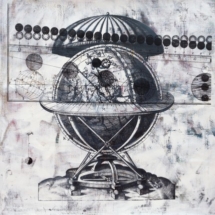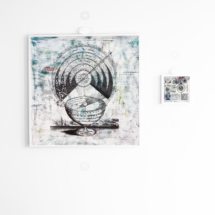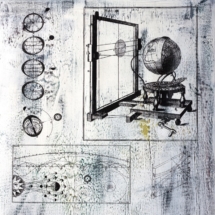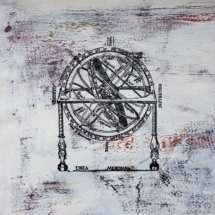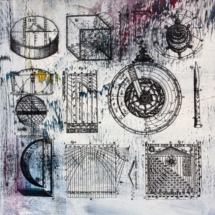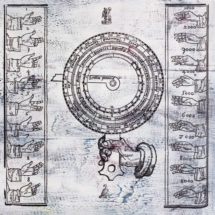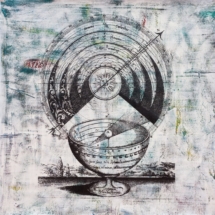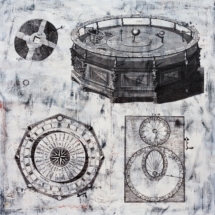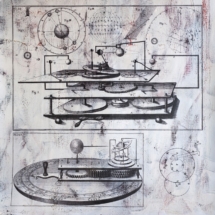Cetus Quasar
Glauber Ballestero
Cetus Quasar. The perpetual invention of a visual universe.
In Glauber Ballestero’s world the number 8 is sovereign.
The Chinese consider 8 the lucky number that defines existence through the Ba-Gua, eight trigrams used in Taoist cosmology to represent the fundamental principles of reality, seen as a range of eight interrelated concepts. In the I-Ching or Book of Mutations, there are 8 changes that summarize states of being and natural elements that multiply to reach a total of 64 hexagrams: the complete foundation of the ancient Chinese knowledge system.
However, Glauber Ballestero does not wish to base his system on any other, drinking instead from a number of sources in the history of ideas to create a parallel universe of sorts: Ambalo limbo / Olympus, the site where the Gods dwell. At once Platonic and Borgian in essence, the artist’s own Aleph invites multiple readings and interpretations but always eludes us with its ambiguous beauty.
His series of works are graphically defined by customised anagrams and structured in multiples of 8, each containing 8 part clusters. They bestow enigmatic titles and are represented by their own emblems, flags and languages like republics or nations: they are in fact parallel realities invented by the artist. As in a Stanley Kubrick movie, plants, colours, machinery, clothing, language, and even the most insignificant details of his invented universe are coherent. Fiction is orchestrated in such a tangible way that reality seems to emulate it.
The 8 bodies of works contained in the euphemistically entitled ‘Honolastic Republic of the Dermis Cromopilato’ / Republica honolástica del dermis cromopilato, form an ecosystem whose parts, far from depicting the visible, are the result of the intense processing of existing imagery to render the unexpected. By means of sampling, Ballestero – an avid consumer of film and other expressions of the moving image.
– submits still images appropriated from the TV screen, analogue film or historical photography to intense manipulation, in order to achieve Suprematist-looking paintings. By means of these complex gestures, he seems to tell us that his interest lies not in the filmic narratives, but rather in an epidermal relation to the surface of images on the screen. Such is his interest in materiality, that he has been known for employing flat monitors as a supporting medium for paintings in previous series. This reflects a tautological fascination with materials that links him to Joseph Beuys, a probable reference inherited from his student days at the Superior Institute of Art in Havana (ISA).
Ballestero is careful in observing a few artistic creeds: Minimalism and its cult of the beauty of repetition, and the Suprematist will to reduce visual information to a colour field, are all sources of motivation. To such influences he adds a unique alchemic touch, as in the series of white monochrome paintings, made of pigment blended with powdered celluloid film to explore the politics of race in an ambiguous manner. Nowhere else is more densely populated than on these white, empty surfaces.
As well as alchemy, that philosophical and proto-scientific tradition aimed at purifying and perfecting metals, numerology is an important accomplice in his pursuit. The series operates like a mathematical equation made of changing variables with infinite permutations.
This exhibition presents 8 medium size oil paintings, a site-specific installation and a video work made of fragments of Luis Buñuel’s The Milky Way, P.T.Anderson’s Magnolia and Lars Von Trier’s
Melancholia. There is also a wax sculpture representing a sea mammal. To add to the 88 registered constellations depicting animals, inanimate objects and mythological characters, the artist invents a new constellation: and then saved by God. For ancient Greeks, the constellation represented a whale slayed by Perseus as he saved the princess Andromeda from Poseidon’s wrath.
According to Ballestero’s gospel, the last time that this constellation became visible to humans was in 1492, the same year in which the vast American continent was found, and subsequently, mercilessly conquered by the Spanish crown. A new version of Cetus is becoming visible again, leading us to read the end of an era: the half millennium that marks the birth and evolution of the three pillars of Western civilisation: capitalism, colonisation and modernity.
The paintings in Cetus Quasar are complex and layered as encyclopaedic depictions of
astronomical references. The imagery, taken from a variety of archival sources such as
astronomy treaties, depict globes, architectural domes, measuring tools and other iconographic elements from medieval prints, laid on textured oil backgrounds to create a fable. Paying homage to the old masters of photography – an art that interests him precisely due to its alchemic properties – he transfers the digital images into wax to construct a layered universe that behaves like a film made of still fragments. Significantly, the artist’s gesture could recall Salut les Cubains, the emblem- atic filmic montage made by the avant-garde Belgian filmmaker Agnès Varda at the birth of the Cuban Revolution.
Quasars (quasi stars) are powerful, luminous, and energetic objects in the center of a massive galaxy, sur- rounding a central massive black hole. Perhaps the quasar of these series suggests hope, a concentrated resplendent possibility at the core of our general dystopia.
text by Gabriela Salgado Curator
London, February 2016
